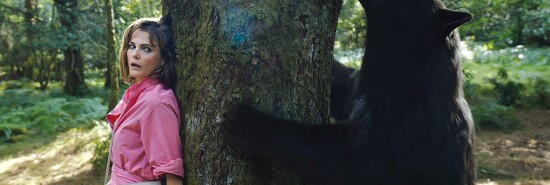
Grin and Cocaine Bear it
Chris Vognar
If Snakes on a Plane was too substantive for you, Cocaine Bear might just be your jam. Like Snakes on a Plane, the 2006 Samuel L. Jackson thriller that thrived as a premise on the internet before it ever saw the light of day, Cocaine Bear is an idea in search of an actual movie. The concept is simple enough: What would happen if a large bear consumed large quantities of cocaine? The real-life answer, from the true story on which Cocaine Bear is sort of based, is that the bear would unceremoniously die. But that would make for a short, sad movie, as opposed to a slogging, stupid one.
As Cocaine Bear hobbles toward its welcome conclusion, it somehow makes room for a desperate mother (Keri Russell, I hope you got paid) searching for her little girl. This is the moment when the film wipes out any goodwill it might have built up. You do not vomit a slack 90-minute Saturday Night Live sketch of a movie onto the screen and then ask us to care. Such atrocities violate several treaties, or anyway they should. Either commit to your broad, gory comedy or stop altogether. Frankly, the latter would have been preferable.
Cocaine Bear, like the recent 80 for Brady, must have started as one of those pitches that sounded funny. Then, the harsh realization dawns: We actually have to make the damn thing. That was the turning point at which sentient audiences could have been saved. Alas, the suits moved ahead. A drug smuggler flying over the South has an airplane mishap, and his cargo is scattered on the ground below. Said bear finds some of the white stuff and gobbles it up. The rest is severed limbs, gobbled guts, and various attempts to bring CB to justice. Unfortunately, there’s still a story to write and characters to create. You know, movie stuff.
Among those on the trail of the cocaine bear: Isiah Whitlock Jr., as a police detective searching for the lost coke; Margo Martindale, as a craven park ranger who accidentally blows a guy’s head off (for comic effect, of course); the aforementioned Russell, who apparently didn’t get the memo about not actually having to act here; O’Shea Jackson Jr. (son of Ice Cube) and Alden Ehrenreich, as a couple of criminal errand boys; and, God bless, Ray Liotta, in his final screen performance, as the drug kingpin who wants his goods back. They all go traipsing through the Georgia woods, a pileup of misshapen character motivation interrupted not often enough by bloody mauling. At one point, the bear sniffs a line off of a dismembered leg. This is the highlight of the movie. Look no further.
There are a couple of ways a movie like Cocaine Bear could have gone. The first is complete exploitation trash — fast, cheap, and out of control, but with a little budget to make the violence look good. Dispose of the cringey dialogue bits, which play like limp improv, and go for the jugular, literally and figuratively. Countless B-horror movies have followed this path. Then, there’s the route Cocaine Bear takes, with talented people trying really hard to be funny and create something from Jimmy Warden’s wafer-thin script, which includes, yes, a mother searching for her little girl. Roger Corman would hang his head in shame.
Cocaine Bear is somehow both too stupid and not stupid enough. It ends up caught in a boggy middle ground between the exploitation movies of yore and the Hollywood mediocrity of today. It’s a joke without being terribly funny, save for the occasional reflex laugh (such as when Whitlock’s detective waxes about federal drug laws in the years since President Richard Nixon, an incongruous blast of policy opinion in a movie made for people who couldn’t tell you the first thing about Nixon). This is what Snakes on a Plane and Sharknado hath wrought: a philosophy that dictates bad is good but the squishy in-between is the inevitable result.
Which leaves us, at least, with a coked-up bear. It’s not bad, as digitized animal jobs go. In its relentless pursuit of staying high, it brings to mind a wise old adage of George Carlin: “What does cocaine make you feel like? It makes you feel like having more cocaine.” The movie includes the classic “This is your brain on drugs” TV ad and offers tongue-in-cheek warnings about the drug’s dangers (but also shows a couple of little urchins eating a bunch). At least it makes an effort to live in its 1985 milieu.
But it’s still a bad case of placing marketing over moviemaking, or smashing an idea over the head until it’s long and flat enough to fill a theater’s daily screening slots and sell concessions. It is the epitome of product, or, as the kids like to say these days, “content.” A bear does indeed s*** in the woods. This is what it leaves.
Chris Vognar is a culture writer living in Houston.
